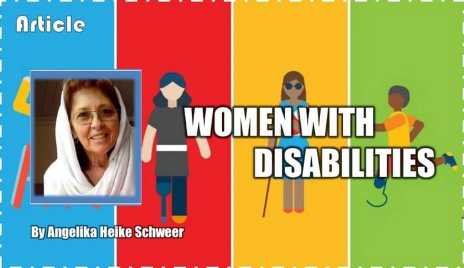Women with Disabilities
By Angelika Heike Schweer
About 650 million people in the world — or 10 percent of the world’s population — live with disabilities, and frequently encounter a myriad of physical and social obstacles. They often lack the opportunities of the mainstream population and are usually among the most marginalized in society. Women face barriers to full equality and advancement because of such factors as race, age, language, ethnicity, culture, religion, or disability. The persistence of certain cultural, legal, and institutional barriers makes women and girls with disabilities the victims of two-fold discrimination: as women and as persons with disabilities.
Girls and women of all ages with any form of disability are among the more vulnerable and marginalized of society. There is, therefore, a need to take into account and address their concerns in all policy-making and programming. Special measures are needed at all levels to integrate them into the mainstream of development.
Rights Of Persons With Disabilities
Often, women with disabilities are invisible both among those promoting the rights of persons with disabilities, and those promoting gender equality and the advancement of women. This page on Women with Disabilities aims to increase awareness about the rights and the situation of women with disabilities by serving as a portal to resources and the work of the United Nations in this area.
People with disabilities, in general, face difficulties in entering the open labor market, but, seen from a gender perspective, men with disabilities are almost twice as likely to have jobs than women with disabilities. When women with disabilities work, they often experience unequal hiring and promotion standards, unequal access to training and retraining, unequal access to credit and other productive resources, unequal pay for equal work and occupational segregation, and they rarely participate in economic decision-making.
Women with disabilities, of all ages, often have difficulty with physical access to health services. Women with mental disabilities are particularly vulnerable, while there is limited understanding, in general, of the broad range of risks to mental health to which women are disproportionately susceptible as a result of gender discrimination, violence, poverty, armed conflict, dislocation, and other forms of social deprivation.
The Challenges: Multiple Discriminations And Societal Barriers
Women face barriers to full equality and advancement because of such factors as their race, age, language, ethnicity, culture, religion, or disability.
People with disabilities often encounter attitudinal and environmental barriers that prevent their full, equal, and active participation in society. These barriers impinge particularly on the well-being of persons with intellectual, mental, or multiple disabilities. They add to the disadvantage customarily experienced by disabled persons belonging to such populations or social groups as women, children, the elderly, and refugees.
“The consequences of deficiencies and disablement are particularly serious for women. There are a great many countries where women are subjected to social, cultural, and economic disadvantages which impede their access to, for example, health care, education, vocational training, and employment. If, in addition, they are physically or mentally disabled, their chances of overcoming their disablement are diminished,۔ which makes it all the more difficult for them to take part in community life” ۔(World Programme of Action concerning Disabled Persons,۔ paragraph 45, General Assembly resolution 37/52 of 3 December 1982).
Women with disabilities may be particularly at risk due to stigmas associated with both disability and gender inequality
“Thus we would now like to focus our attention on the negative consequences for women۔ of the persistence of certain cultural barriers۔ that make them the victims of two-fold discrimination: as women and as disabled persons. Much has been written on discrimination against women. But very little has so far been done to deal adequately with the problem of disabled women.
The few attempts made have been based on a mistaken approach۔ since they treat the acute problem of disability as part of the general topic of discrimination against women. However, sex and disability are two separate factors. When combined in the same person. Usually, reinforce each other and compound prejudices” (1988, “Human Rights and Disabled Persons”, Human Rights Studies Series, Number 6. Centre for Human Rights: Geneva, United Nations publication, Sales No. E.92.XIV.4, § 140).
(This article is based on publications from UN Women Watch – Information and Resources on Gender Equality and Empowerment of Women)
Angelika H. Schweer (30. December 2016)




